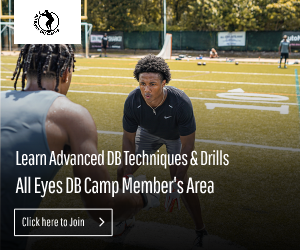There are some things in life you just can’t get around. Times will change but certain things will stay the same. This happens in the game of football too and it also applies to defensive back.
As offenses have evolved and rules have changed, the schemes and tactics to defend them have adjusted. Mankind had to adjust to the invention of the radio, the television and the Internet. Despite that, there are certain things that don’t change and when you know what those things are, you can have a leg up in life and on the football field.
In this article today, I am going to go over the five essential moves, every defensive back must be able to execute to win consistently in coverage. I am sure some will read the list and have their own opinion about other moves that should be a part of the list. I am certainly not here to discount your opinion but I am bringing you this list with the power of 40 years of playing, coaching and training the position. Over time, I have found these things to consistently be necessary for a defensive back’s survival. Furthermore, all other moves seem to be born off of these five core movements described below.
(1) Back Pedal
Yes all you who are trying to cancel this movement. I am talking to all of you coaches and trainers out there that insist on having your athletes prematurely turned and playing into the hands of the wide receivers. Back pedal is still king. Being able to gain ground with your eyes forward while having the equal ability to break to your left or right is the essential task of the position. Being able to back pedal gives you that ability. Whether you are a safety playing on the hash or in the post or a cornerback playing off of a wide receiver in zone or man, being able to stay square with a smooth / fast back pedal will make you a covering God. Start turning your shoulders too fast and you will be food for any good wide receiver or quarterback.
(2) Weave
Weaving is the cousin of the back pedal. You must keep it all in the family. Back pedaling only allows you to go straight back in a line. At some point, a receiver attacks your leverage or moves laterally. Being able to weave allows you to stay square while covering ground left or right. Staying square allows you to efficiently change direction if and when you need to. If a receiver moving laterally means you have to turn your shoulders then you will put yourself at a disadvantage when he changes direction. If a receiver realizes this causes you an issue then they will repeatedly set you up with lateral movement to attack your back. A good weave takes that power away from the receiver.
(3) Hip Flip
Even with the greatest of weaves, you will have to open up at some point. When you do open up and run, many times the receiver will change sides in an effort to attack your blindspot (your back). Being able to flip your hips allows you to keep your eyes on the receiver. There will be times when you will have to speed turn and take your eyes off of the receiver or the quarterback but the better your hip flip is the less times you will need that. You never want to go blind in coverage and having to speed turn is exactly what that is. The better your hip flip, the less times you go blind on the football field.
(4) Breaks
If you are back pedaling or running then you will undoubtedly have to come out of your breaks. The speed at which you can come out of your breaks is everything for a defensive back. Needing more than the required amount of steps or failing to be able to execute the break properly will lead to you watching a lot of balls get caught by receivers. Eventually you will have to watch those balls get caught from the sidelines. If you are a defensive back and you are not good at coming out of your breaks then are you really even a defensive back? No breaks no DB.
(5) Kick Slide
Yes I know you were wondering about press coverage. Press is important (not nearly as much as some believe) and there is one important movement that one must be able to execute to be good at it. Kick slide is that move. Much like the weave, being able to move laterally with a wide receiver’s release off the line of scrimmage gives you the ability to widen their release. Doing this changes the shape of the route, disrupts the timing and allows you to get more physical with the receiver. That is the essence of press man coverage also known as bump and run. The whole reason that it was invented was for the elements I just described. As time has gone on, receivers have gotten more skilled in their releases. As such, being able to move laterally upon their attempts to get up field is a must if you want to have any consistency playing press coverage.
That isn’t all there is to playing defensive back of course but at the core of the position are those five moves. Everything you need to do in terms of movement will start with these five things. Master these moves and you are on your way to being good at the position. If you are struggling in one or more of these movements then my message to you is tighten up. You have to get the basics down before you progress to anything else.
If you are interested in knowing how to master these moves and learning the advanced techniques of playing defensive back along with learning coverages and other key parts of the position, check out the All Eyes DB Camp Member’s Area. Your path to being elite awaits you. Click here for more info.
Chad Wilson is the owner of All Eyes DB Camp and author of "101 DB Tips". He played college football at the University of Miami and briefly in the NFL for the Seattle Seahawks. Over his 15 year high school football coaching career, he tutored over a dozen Division I defensive backs and as a trainer has worked with NFL All Pros, first round draft picks, college football All Americans and Top 10 ranked high school football prospects.









